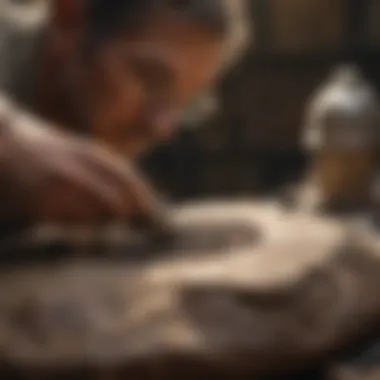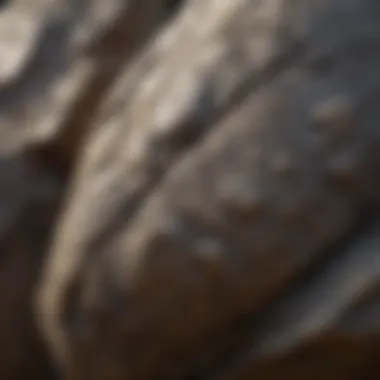Unveiling the Top Dremel Tools for Rock Polishing Enthusiasts


Rock and Fossil Identification
Rock and fossil identification is an essential skill for any aspiring rock polishing enthusiast. Understanding the types of rocks and fossils you may encounter, as well as the characteristics to look for, can greatly enhance your experience in this field. By knowing the tools required for identification, you equip yourself with the knowledge needed to distinguish between different materials accurately. Whether you're a novice or a seasoned collector, honing your identification skills is fundamental in selecting the best Dremel tool for rock polishing.
Collecting Tips and Techniques
Delving into the world of rock polishing goes hand in hand with effective collecting practices. Discover the best tips for collecting rocks and fossils, from identifying prime collection sites to safely extracting specimens. Uncover the nuances of locating ideal spots for collecting and learn how to handle the extraction process with care and precision. Implementing these techniques not only enriches your collection but also ensures the availability of high-quality materials for your rock polishing projects.
Preservation and Display
Preservation is paramount in maintaining the integrity of your rock and fossil collection. Explore various techniques for preserving rocks and fossils, along with optimal storage methods to extend their lifespan. Additionally, delve into creative display ideas that showcase your specimens in all their glory. From choosing the right preservation method to curating captivating displays, elevating your preservation and display skills enhances the beauty and longevity of your collection.
Geological Insights
Dive deep into the geological aspects of rock polishing as you unravel the formations and processes that shape our planet. Explore the historical significance of rocks and fossils, understanding their role in illuminating the Earth's past. Discover notable discoveries in the field that have revolutionized our understanding of geology and paleontology. Engaging with these geological insights not only enriches your knowledge but also provides a foundation for appreciating the complexities and wonders of the natural world.
Introduction
Understanding the Importance of the Right Tools
Embarking on the path of rock polishing necessitates a keen understanding of the pivotal role that the right tools play in sculpting exquisite creations from rough stones. The quest for the ideal Dremel tool transcends mere functionality; it epitomizes the convergence of precision, power, and versatility essential for shaping raw rocks into gems of beauty. By comprehending the nuances of each Dremel offering, enthusiasts can discern the fine balance between efficiency and craftsmanship, paving the way for unparalleled results in their rock polishing endeavors. Selecting the optimal Dremel tool is not merely a choice but an investment towards elevating one's artistry and skill in the captivating world of rock polishing.
Overview of Dremel Tools
Dremel tools stand as paragons of innovation and quality in the realm of precision craftsmanship. Boasting a myriad of offerings tailored to cater to the diverse needs of artisans and hobbyists alike, Dremel tools transcend mere functionality to embody a blend of ergonomic design, cutting-edge technology, and versatile applications. From the flagship Dremel 4300, a symbol of power and performance, to the compact elegance of the Dremel Lite, each model in the Dremel pantheon is crafted to deliver unparalleled control and finesse in rock polishing. An exploration into the array of Dremel tools unravels a tapestry of creativity and precision, offering enthusiasts a gateway to unleash their artistic prowess upon the rugged canvas of raw rocks with unmatched dexterity and finesse.


Factors to Consider
Rock polishing necessitates a meticulous selection process when it comes to the tools employed. Within the realm of Dremel tools, several key factors demand attention to elevate the rock polishing experience to unprecedented heights. First and foremost, speed and power play a pivotal role in determining the efficacy of a Dremel tool for this task. The ability to adjust the speed settings according to the hardness of the rocks is crucial for a seamless polishing process. Moreover, a high-power motor ensures efficient material removal and smoother finishing. When considering a Dremel tool for rock polishing, versatility and attachments should not be overlooked. A diverse range of attachments catering to different rock types and textures empowers collectors to achieve varied finishes and intricate detailing. The ergonomic design of the Dremel tool significantly impacts the comfort level during prolonged use. A well-balanced, ergonomically designed tool reduces fatigue and enhances control over the polishing process, ultimately leading to superior results. Therefore, in the pursuit of the best Dremel for rock polishing, analyzing these factors is imperative to make an informed decision
Speed and Power
When evaluating Dremel tools for rock polishing, one cannot overlook the critical aspects of speed and power. The rotary speed range offered by a Dremel tool determines its versatility in handling different rock types and sizes. An adjustable speed setting allows for customization based on the hardness of the rocks, ensuring precision and optimal results. Correspondingly, the power of the Dremel tool's motor dictates its efficiency in material removal and shaping. A high-power motor not only accelerates the polishing process but also enhances the overall smoothness and consistency of the finish. The perfect symbiosis between speed and power is essential for rock polishing, as it directly impacts the quality and efficiency of the project
Versatility and Attachments
The versatility of a Dremel tool for rock polishing extends beyond its basic functions. Choosing a tool with a wide array of compatible attachments opens up a world of possibilities for rock enthusiasts. From grinding stones to polishing pads, the right attachments can transform the outcome of the polishing process. Each attachment caters to specific rock textures and shapes, allowing for customized finishes and intricate detailing. By investing in a Dremel tool with versatile attachments, collectors can experiment with various techniques and achieve exceptional results across different types of rocks
Ergonomics and Comfort
In the realm of rock polishing, ergonomic design stands out as a crucial factor for an enjoyable and efficient polishing experience. The ergonomics of a Dremel tool encompass its weight distribution, grip comfort, and overall user-friendly design. Opting for a tool that fits comfortably in hand and offers optimal balance reduces strain and fatigue during extended polishing sessions. Additionally, easy access to controls and comfortable grip materials enhance user control and precision. Prioritizing ergonomic factors ensures a seamless polishing process, allowing collectors to focus on the artistry and intricacies of rock polishing without physical discomfort
Top Dremel Options for Rock Polishing
In this section of the article
Comparison of Features
In the realm of rock polishing, the comparison of features among different Dremel tools holds immense importance. This aspect serves as the compass for enthusiasts to navigate through a sea of options and pinpoint the tool that aligns perfectly with their needs and expectations. By dissecting and evaluating the features offered by each Dremel model, rock and fossil collectors can make informed decisions, ensuring optimal results in their polishing ventures.
Delving deeper, the rotary speed range stands out as a pivotal feature when assessing Dremel tools for rock polishing. This aspect dictates the tool's capability to adapt to various rock types, sizes, and textures efficiently. Higher rotary speed settings can tackle tougher rocks that demand more aggressive polishing, while lower speeds cater to delicate rocks that necessitate a gentler touch. Rock and fossil collectors must strike a balance between speed and precision, tailoring the rotary speed to each specific rock's requirements to achieve impeccable polishing results.
Moving on to the compatibility with accessories, a crucial consideration when selecting a Dremel tool for rock polishing. The seamless integration between the tool and a myriad of accessories amplifies its versatility and functionality. Compatibility ensures that rock enthusiasts can experiment with different attachments, including polishing bits, grinding discs, and abrasive wheels, expanding the tool's utility beyond basic polishing. This feature empowers users to customize their rock polishing techniques, adapt to varying rock compositions, and unleash their creativity in achieving distinct polished finishes.


Lastly, the ease of use emerges as a defining factor that influences the overall rock polishing experience. Dremel tools engineered with user-friendly designs, intuitive controls, and ergonomic handles elevate the comfort level during prolonged polishing sessions. Enhanced ease of use translates to smoother operation, precise control over the polishing process, and reduced fatigue, enabling rock and fossil collectors to focus on honing their craft and achieving superior rock polishing outcomes effortlessly.
Rotary Speed Range
'Rotary speed range' serves as a cornerstone feature for selecting the ideal Dremel tool for rock polishing endeavors. This characteristic encompasses the spectrum of rotational speeds that a Dremel model can deliver, ranging from lower RPMs to higher RPMs based on user adjustments. The versatility of rotary speed range empowers rock and fossil collectors to tailor the polishing process according to the intrinsic properties of each rock, ensuring optimal polishing results.
A higher rotary speed proves invaluable when dealing with dense or hard rocks that necessitate more vigorous polishing actions. The increased speed allows for quicker material removal, efficient polishing, and smoother finishes on challenging rock surfaces. Conversely, lower rotary speeds cater to softer rocks, delicate detailing work, or intricate polishing tasks that require precision and finesse. By fine-tuning the rotary speed settings, enthusiasts can address the diverse requirements of different rocks, ensuring thorough polishing while preserving the rock's integrity.
Moreover, the rotary speed range directly impacts the effectiveness of various polishing accessories, such as diamond bits and sanding drums, optimizing their performance based on the rotational speed selected. This synergy between the speed range and accessories enhances the versatility and adaptability of the Dremel tool, catering to a wide range of rock polishing techniques and achieving desired results with finesse.
Compatibility with Accessories
The compatibility with accessories plays a pivotal role in augmenting the functionality and versatility of Dremel tools for rock polishing endeavors. This characteristic delineates the flexibility of a Dremel model to accommodate a diverse array of accessories, ranging from polishing bits and sanding drums to cutting discs and grinding stones. The seamless integration of accessories into the tool's design expands the scope of rock polishing techniques that enthusiasts can explore and master.
Rock and fossil collectors benefit greatly from the versatility that stems from accessory compatibility. By effortlessly attaching and detaching various accessories to their Dremel tool, enthusiasts can transition between different polishing tasks, experiment with unique textures and finishes, and adapt their techniques to suit the specific characteristics of each rock. This adaptability empowers users to refine their polishing skills, explore creative avenues in rock finishing, and achieve tailored results that reflect their artistic flair and precision.
Furthermore, the compatibility with a wide range of accessories ensures that Dremel tools remain dynamic and versatile tools in the hands of rock enthusiasts, capable of addressing diverse rock types and polishing requirements with finesse. From intricate detailing to comprehensive polishing, the ability to pair the right accessory with the Dremel tool amplifies efficiency, precision, and creativity, culminating in superior rock polishing outcomes.
Ease of Use
The ease of use stands at the forefront of considerations when selecting a Dremel tool for rock polishing, profoundly influencing the efficiency, comfort, and overall satisfaction of the polishing experience. Dremel models engineered with user-friendly features, ergonomic designs, and intuitive controls elevate the usability of the tool, enhancing the polishing process for rock and fossil collectors across different skill levels.
Enhanced ergonomics, characterized by comfortable grips, lightweight constructions, and balanced designs, promote prolonged usage without inducing fatigue or strain, ensuring optimal control and precision during polishing tasks. The ergonomic considerations not only prioritize user comfort but also facilitate seamless maneuverability around intricate rock surfaces, enabling users to execute precise polishing techniques effortlessly.
In addition to ergonomic design, intuitive controls play a fundamental role in simplifying the operation of the Dremel tool during rock polishing sessions. Easy-to-access speed adjustments, hassle-free accessory changes, and clear operational indicators streamline the polishing workflow, empowering users to focus on refining their techniques, experimenting with different accessories, and achieving consistent polishing results. The user-centric approach to control mechanisms fosters a seamless polishing experience, allowing rock enthusiasts to unleash their creativity and expertise without impediments.
Overall, the ease of use encapsulates the fusion of ergonomic excellence, operational simplicity, and user-centric design elements, culminating in a frictionless rock polishing journey for enthusiasts. By prioritizing ease of use in Dremel tools, rock and fossil collectors can elevate their polishing prowess, optimize their workflow, and immerse themselves in the artistry of transforming rough rocks into resplendent gemstones with precision and ease.


Conclusion
In the realm of rock polishing, selecting the ideal Dremel tool serves as a pivotal decision that can profoundly influence the outcome of your crafting endeavors. As rock and fossil collectors delve into the exquisite art of rock polishing, the importance of a well-suited Dremel for this precise task cannot be overstated. The Conclusion section of this comprehensive article encapsulates key insights and considerations essential for making an informed choice when it comes to selecting the perfect Dremel for rock polishing.
Upon delving into the intricate world of rock polishing, factors such as speed, power, versatility, and comfort take center stage in the decision-making process. These elements play a crucial role in determining the efficiency and quality of the rock polishing results. An in-depth understanding of how each of these factors interplays with the craft allows enthusiasts to make a well-informed decision when choosing a Dremel for rock polishing.
Moreover, the Conclusion section sheds light on how selecting the right Dremel can enhance not only the final polished result but also the overall crafting experience. An ergonomic design that prioritizes comfort can significantly reduce hand fatigue during extended polishing sessions, ensuring a seamless and enjoyable experience for rock enthusiasts of all levels. By selecting a Dremel that aligns with your specific needs and preferences, you can elevate your rock polishing endeavors to new heights of precision and artistry.
With a keen focus on offering an in-depth analysis and insightful guidance, the Conclusion section serves as a beacon for rock and fossil collectors seeking to elevate their craft through the discerning choice of a Dremel tool tailored for rock polishing.
Selecting Your Ideal Dremel for Rock Polishing
Expanding on the pivotal decision of selecting the ideal Dremel for rock polishing, this section delves into the intricate considerations and features that rock enthusiasts should prioritize when making this crucial choice. From rotary speed ranges to compatibility with accessories, each aspect plays a crucial role in determining the efficiency and precision of rock polishing results.
When selecting your ideal Dremel for rock polishing, it is imperative to consider your specific needs and the type of rocks you intend to polish. Different Dremel models offer varying speed ranges, with some designed for intricate detailing work while others excel in rapid material removal. Understanding the requirements of your rock polishing projects is essential in choosing a Dremel that aligns with your unique preferences and crafting style.
Additionally, the section highlights the significance of compatibility with a diverse range of accessories, which can enhance the versatility and functionality of your Dremel tool. By choosing a Dremel that seamlessly integrates with a variety of accessories such as grinding stones, polishing wheels, and sanding bands, you broaden the horizons of your rock polishing capabilities, enabling you to explore a myriad of techniques and finishes.
Furthermore, ergonomics and ease of use are paramount factors to consider when selecting your ideal Dremel for rock polishing. A comfortable grip and intuitive controls can significantly amplify your efficiency and precision during the polishing process, granting you a seamless and immersive crafting experience that elevates the art of rock polishing to new heights of excellence.
With a meticulous focus on detail and analysis, the section serves as a comprehensive guide for rock and fossil collectors, enlightening them on the nuanced considerations that underpin the selection of the perfect Dremel for rock polishing.
Enhancing Your Rock Polishing Experience
Transitioning from the technical aspects of selecting a Dremel for rock polishing, this section delves into how enthusiasts can enhance their overall rock polishing experience through thoughtful strategies and techniques. From optimizing workspace setup to integrating advanced polishing methods, this section offers valuable insights to elevate the craft of rock polishing to unparalleled levels of mastery.
Enhancing your rock polishing experience begins with creating an ergonomic and well-equipped workspace that facilitates seamless crafting. Organizing your tools, accessories, and work surface in a clutter-free and efficient manner not only streamlines the polishing process but also minimizes distractions, allowing you to focus wholeheartedly on refining your rock specimens to perfection.
Moreover, the section delves into advanced rock polishing techniques that can transform your creations from ordinary to extraordinary. From gradient polishing to intricate detailing, experimenting with diverse methods and styles can add a unique flair to your polished rocks, making each piece a masterpiece of artistry and skill.
Furthermore, the section emphasizes the importance of proper maintenance and care for your Dremel tool to ensure longevity and optimal performance. Regular cleaning, lubrication, and storage practices can extend the lifespan of your Dremel, preserving its efficiency and functionality for countless rock polishing projects to come.
By immersing yourself in the enriching insights and practical tips offered in this section, you can embark on a journey to not only polish rocks but to sculpt masterpieces that reverberate with precision, creativity, and passion. Enhancing your rock polishing experience transcends mere craftsmanship; it embodies a deep appreciation for the art form and a commitment to continual growth and excellence in the world of rock and fossil collection.







